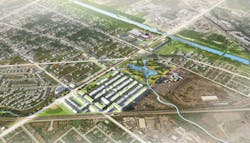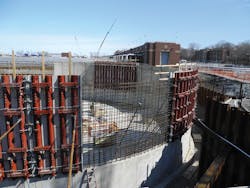Water Infrastructure Funding: Where Do We Go From Here?
By Sarah Fister Gale
Donald Trump made big claims during the election about a plan to invest $1 trillion in America’s infrastructure, indicating he would make water a top priority. Indeed, it was one of the least controversial aspects of his campaign. There is a currently a $600 billion funding gap for water and wastewater infrastructure, and the need to invest in these systems is one of the few things both parties actually agree on. “These are real numbers that no one is disputing,” said Adam Kranz, CEO of the National Association of Clean Water Agencies (NACWA) in Washington, D.C. “Now we need real money on the table to address them.”
The president’s vision includes developing a long-term water infrastructure plan to upgrade aging water systems, and tripling funding for state revolving fund (SRF) programs to help states and local governments upgrade critical drinking water and wastewater infrastructure. It’s an enticing promise for communities across the country that are struggling with aging systems and the cost of upgrading their infrastructure to meet new regulatory requirements. However it remains to be seen whether his administration will follow through on all of these investment promises, and more importantly, where all the money will come from. “All I can say now is ‘who knows?’” said Kranz.
Bonds, Funds, and Rate Increases
Kranz does believe there will be more money on the table for water infrastructure during this administration based on Trump’s vision statement and his desire to be viewed as a builder. However, Republicans have also made it clear that they intend to cut back spending, so Kranz worries that any money put in place for water infrastructure may come at the expense of other important programs. “The goals within the administration suggest a level of conflict,” he said.
Mike Keegan of the National Rural Water Association is especially concerned about how funding for specific projects will get prioritized. His members are all small communities with significant infrastructure needs, and they worry that the current administration will funnel funds to more affluent communities through WIFIA, which is for larger projects and limited to communities with good credit. “A lot of the communities with the greatest need can’t access that kind of funding, which is limiting for our members,” he said.
Another vital source of funding that might be at risk are tax exempt bonds. “Tax exempt municipal bonds are a very important tool for municipalities of all sizes,” said Tracy Mehan, executive director of government affairs for the American Waterworks Association (AWWA). They give local bodies access to low-cost capital and the power to issue bonds for specific projects based on the needs of their communities, rather than leaving these decisions to federal bodies. However, Republicans have vowed to overhaul the tax code and have made it clear that everything is on the table. “There has been specific talk about getting rid of the tax exempt status for municipal bonds, which has a lot of utility folks concerned,” added Tommy Holmes, director of federal legislation for AWWA.
NACWA, AWWA, and 27 other industry organizations wrote a letter to Congress in January, encouraging the new administration not to eliminate tax-exempt municipal bonds, noting that they have been used to finance more than $2 trillion in infrastructure investments over the past ten years and are on a path to finance another $2 trillion in the next ten years. “It’s an important finance tool for the water utility industry,” Holmes said, noting that the loss of tax-exempt status would deliver a significant blow to water infrastructure investment.
Julius Ciaccia, CEO of Northeast Ohio Regional Sewer District in Cleveland, believes communities shouldn’t count on government funding for these projects, and that they need to consider rate increases to fill the funding gaps. He notes that after big grants for wastewater infrastructure projects dried up in the 90s, Cleveland had no choice but to raise rates to cover the cost of upgrades. “We’ve all seen what happens when utilities don’t invest in their infrastructure,” he said. Cleveland residents saw 12 percent annual rate hikes over the past five years, and will see another 8.3 percent increase per year through 2021, with additional funds supporting Project Clean Lake, a federally mandated $3 billion effort to reduce stormwater runoff into Lake Erie.
The rate increases are significant, but Ciaccia noted that they are comparable to gas and electric rates for residents, and align with the real cost of managing the water and wastewater systems. “A lot of utilities’ rates are still way undervalued when you consider the cost of the service we provide,” he explained. And while increases can be a tough sell for residents, it’s better than running the system to failure. “You have to have strong leadership and you have to communicate about the value of the water system to help people understand what they are getting,” he said. “It’s something that all utilities need to do better.”
Value in Teamwork
The reality is that regardless of who is in office, there are no easy solutions to the country’s water infrastructure crisis. Municipalities and utilities need to rely on a number of funding sources and strategies to deliver any projects, and the more innovation they can get the better, said David St. Pierre, executive director of the Metropolitan Water Reclamation District of Greater Chicago (MWRD). MWRD has 80 ongoing projects as part of its five-year capital program. St. Pierre is focused on finding more innovative strategies to fund these and other badly needed water infrastructure projects, in large part by working more collaboratively with communities and state agencies.
MWRD’s primary source of financing is through bonds and the SRF, and they encourage communities to match funds when possible. Being able to access SRF funds is particularly helpful because it gives local communities the confidence to participate financially in these projects, he said. “Because we can match them, they are willing to leverage their own funds, whereas on their own they are afraid to makes these kinds of commitments.”
But to have a real impact, communities need to think beyond traditional water funding sources. He points to a unique project in Robbins, Ill., that he hopes will become a model for future infrastructure development. The small community had significant flooding problems, and while MWRD could have come in and “dug a big hole” to address the flooding, his team wondered if they could do more for the struggling community.
They ultimately partnered with 50 government agencies and private organizations to design and fund a three-tiered infrastructure amenity project, complete with wetlands, athletic fields, parks, paths, shops, green energy infrastructure and a residential community near the metro. “We brought all of these public and private stakeholders together and showed them that if we work together we can get so much more done,” he said. The project is still in the design phase, but everyone is excited about the potential, and they have all agreed to contribute funds. The project is expected to break ground in 2018.
St. Pierre sees these kinds of collaborations as the key to getting big infrastructure projects off the ground, and the future for water infrastructure funding. “I can’t solve every problem with a $20 million a year budget,” he said. “But if we get out of our niches and work together we can accomplish so much more.”
About the Author: Sarah Fister Gale is a Chicago-based correspondent for WaterWorld. Over the last 15 years, she has researched and written dozens of articles on water management trends, wastewater treatment systems and the impact of water scarcity on businesses and municipalities around the world.



